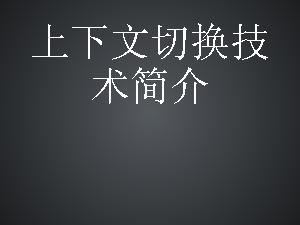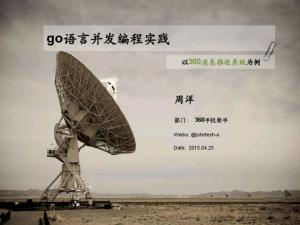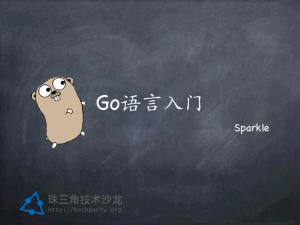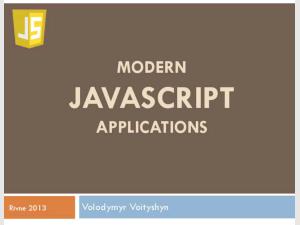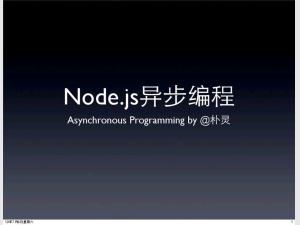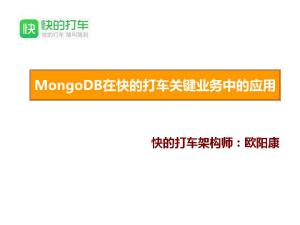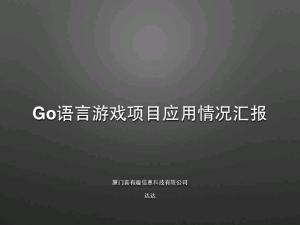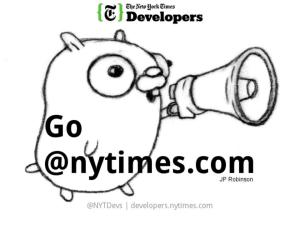加收藏
Google开发团队亲自介绍Angular 2
第1页
Angular 2
Miško Hevery (@mhevery) Rado Kirov (@radokirov)
Miško Hevery (@mhevery) Rado Kirov (@radokirov)
第3页
Angular 2 Syntax
第4页
Familiar vs
Simple
Simple
第5页
data binding
第6页
Angular 1: binding semantics
<component title="Literal"> <component title="expression"> <component title="{{interpolate}}">
<component title="Literal"> <component title="expression"> <component title="{{interpolate}}">
第7页
Angular 2: binding semantics
<component title="Literal"> <component [title]="expression">
<component title="Literal"> <component [title]="expression">
第8页
Angular 2: binding questions
● Is [property] a valid HTML?
● Why [property]=expression
not property={{expression}}?
● What about {{interpolation}}?
● Is [property] a valid HTML?
● Why [property]=expression
not property={{expression}}?
● What about {{interpolation}}?
第9页
Is [property] a valid HTML?
The HTML syntax spec:
Attribute names must consist of one or more characters other than the space characters, U+0000 NULL, U+0022 QUOTATION MARK ("), U+0027 APOSTROPHE ('), ">" (U+003E), "/" (U+002F), and "=" (U+003D) characters, the control characters, and any characters that are not defined by Unicode. In the HTML syntax, attribute names, even those for foreign elements, may be written with any mix of lower- and uppercase letters that are an ASCII caseinsensitive match for the attribute's name.
The HTML syntax spec:
Attribute names must consist of one or more characters other than the space characters, U+0000 NULL, U+0022 QUOTATION MARK ("), U+0027 APOSTROPHE ('), ">" (U+003E), "/" (U+002F), and "=" (U+003D) characters, the control characters, and any characters that are not defined by Unicode. In the HTML syntax, attribute names, even those for foreign elements, may be written with any mix of lower- and uppercase letters that are an ASCII caseinsensitive match for the attribute's name.
第10页
Why [property] not {{expression}}
<img src="user.png"> <img src="{{user.name}}.png"> <img ng-src="{{user.name}}.png">
<img src="user.png"> <img src="{{user.name}}.png"> <img ng-src="{{user.name}}.png">
第11页
Why [property] not {{expression}}
<button disabled="{{exp}}"> <button ng-disabled="exp">
<button disabled="{{exp}}"> <button ng-disabled="exp">
第12页
Why [property] not {{expression}}
<pane title="{{title}}" selected="{{isSelected}}">
<pane escape-title="title" escape-selected="isSelected">
<pane title="{{title}}" selected="{{isSelected}}">
<pane escape-title="title" escape-selected="isSelected">
第13页
Why [property] not {{expression}}
● Web Components
○ Should act like existing browser elements ○ DOM API: properties, events, methods ○ HTML is serialized version of DOM
● Web Components
○ Should act like existing browser elements ○ DOM API: properties, events, methods ○ HTML is serialized version of DOM
第14页
Why [property] not {{expression}}
● HTML Attributes => DOM properties
○ <input value="initial">
● Properties
○ provide current value var current = input.value;
○ can contain non string values ■ passing model values to child components ■ boolean attributes
● HTML Attributes => DOM properties
○ <input value="initial">
● Properties
○ provide current value var current = input.value;
○ can contain non string values ■ passing model values to child components ■ boolean attributes
第15页
Why [property] not {{expression}}
[property]="expression" binds to
DOM properties
[property]="expression" binds to
DOM properties
第16页
What about {{interpolation}}?
<div title="My Text"> <div title="{{exp}}"> <div [title]="exp.toString()">
<div title="My Text"> <div title="{{exp}}"> <div [title]="exp.toString()">
第17页
Angular 1 vs Angular 2
<div ng-bind="exp"> <div [text]="exp">
<div ng-bind="exp"> <div [text]="exp">
第18页
Angular 1 vs Angular 2
<div ng-bind-html="exp"> <div [inner-html]="exp">
<div ng-bind-html="exp"> <div [inner-html]="exp">
第19页
Angular 1 vs Angular 2
<div ng-hide="exp"> <div [hidden]="exp">
<div ng-hide="exp"> <div [hidden]="exp">
第20页
Unneeded directives
ng-bind ng-bind-html ng-bind-template ng-class ng-class-even ng-class-odd ng-style ng-disabled ng-readonly ng-selected ng-show ng-hide ng-src ng-srcset ng-href ng-value
ng-bind ng-bind-html ng-bind-template ng-class ng-class-even ng-class-odd ng-style ng-disabled ng-readonly ng-selected ng-show ng-hide ng-src ng-srcset ng-href ng-value
第21页
event binding
第22页
Angular 1 expression or statement
<component select="user.name(current)">
<component select="user.name(current)">
第23页
Angular2 - Expression vs Statement
<component
expression
[select]="user.name(current)">
<component
statement
(select)="user.name(current)">
<component
expression
[select]="user.name(current)">
<component
statement
(select)="user.name(current)">
第24页
Angular2 - Expression vs Statement
Expressions
Statements
Syntax [prop]="exp" (event)="stmt" bind-prop="exp" on-event="stmt"
Driven by change detection
event
side-effects (assignments)
no
yes
null suppression
yes
throw error
count (;)
one
multiple
Expressions
Statements
Syntax [prop]="exp" (event)="stmt" bind-prop="exp" on-event="stmt"
Driven by change detection
event
side-effects (assignments)
no
yes
null suppression
yes
throw error
count (;)
one
multiple
第25页
Unneeded directives
ng-blur ng-change ng-checked ng-copy ng-cut ng-paste ng-click ng-dblclick ng-open ng-submit ng-keydown ng-keypress ng-keyup ng-mousedown ng-mouseenter ng-mouseleave ng-mousemove ng-mouseover ng-mouseup
ng-blur ng-change ng-checked ng-copy ng-cut ng-paste ng-click ng-dblclick ng-open ng-submit ng-keydown ng-keypress ng-keyup ng-mousedown ng-mouseenter ng-mouseleave ng-mousemove ng-mouseover ng-mouseup
第26页
ref binding
第27页
Angular 1 - Reference
<button ng-click="?.focus()"> <input type=text name=user>
<button ng-click="?.focus()"> <input type=text name=user>
第28页
Angular 1 - Reference
<button (click)="input.focus()"> <input #input type=text name=user>
<button (click)="input.focus()"> <input #input type=text name=user>
第29页
Angular 1 - Typos
<div tytle="{{usor.name}}"> <button ngClick="ct1.c1ick()"> {{usor.name}} </button>
</div>
<div tytle="{{usor.name}}"> <button ngClick="ct1.c1ick()"> {{usor.name}} </button>
</div>
第30页
Angular 1 - Typos
<div tytle="{{usor.name}}"> <button ngClick="ct1.c1ick()"> {{usor.name}} </button>
</div>
<div tytle="{{usor.name}}"> <button ngClick="ct1.c1ick()"> {{usor.name}} </button>
</div>
第31页
summary
第32页
Angular2 - Summary
Short
Canonical
JavaScript
Property [prop]="exp" Binding
bind-prop="exp" e['prop'] = exp;
Event (event)="stmt" on-event="stmt" e.addEventListener(
Binding
'event', stmt);
Ref #x Binding
var-x
var x = e;
DOM API: properties, events, methods
Short
Canonical
JavaScript
Property [prop]="exp" Binding
bind-prop="exp" e['prop'] = exp;
Event (event)="stmt" on-event="stmt" e.addEventListener(
Binding
'event', stmt);
Ref #x Binding
var-x
var x = e;
DOM API: properties, events, methods
第33页
Web Components
第34页
Angular 1 - Web Components
<button ng-click="v.play()"> <google-youtube
id="v" videoid="{{id}}" head="{{ {start:s, end:e} }}" ng-state="onState($event)">
<button ng-click="v.play()"> <google-youtube
id="v" videoid="{{id}}" head="{{ {start:s, end:e} }}" ng-state="onState($event)">
第35页
Angular 1 - Web Components
var v = document.getElementById(…) v.videoid = id; v.head = {start: s, end: e}; v.addEventListener('state', …); v.play();
var v = document.getElementById(…) v.videoid = id; v.head = {start: s, end: e}; v.addEventListener('state', …); v.play();
第36页
Angular 2 - Web Components
<button (click)="v.play()"> <google-youtube
#v [videoid]="id" [head]="{start:s, end:e}" (state)="onState($event)">
<button (click)="v.play()"> <google-youtube
#v [videoid]="id" [head]="{start:s, end:e}" (state)="onState($event)">
第37页
Microsyntax
第38页
Angular 1 - implicit templates
<ul> <li ng-repeat="item in items"> {{item}} <li>
<ul>
{{item in items}}
<ul> <li ng-repeat="item in items"> {{item}} <li>
<ul>
{{item in items}}
第39页
Angular 2 - explicit templates
<ul> <template foreach #item [in]="items"> <li>{{item}}<li> </template>
<ul>
<ul> <template foreach #item [in]="items"> <li>{{item}}<li> </template>
<ul>
第40页
Angular 2 - explicit templates
<ul> <li template="foreach; #item; in=items"> {{item}} </li>
<ul>
<ul> <li template="foreach; #item; in=items"> {{item}} </li>
<ul>
第41页
Angular 2 - explicit templates
<ul> <li template="foreach #item in items"> {{item}} </li>
<ul>
<ul> <li template="foreach #item in items"> {{item}} </li>
<ul>
第42页
Angular 2 - explicit templates
<ul> <li *foreach="#item in items"> {{item}} </li>
<ul>
<ul> <li *foreach="#item in items"> {{item}} </li>
<ul>
第43页
Simpler Predictable
Toolable
Toolable
第44页
DEMO TIME
第45页
Thank you!
angular 2 - https://github.com/angular/angular slides - http://goo.gl/W4K6dv demo - https://github.com/rkirov/youtube-app
angular 2 - https://github.com/angular/angular slides - http://goo.gl/W4K6dv demo - https://github.com/rkirov/youtube-app

